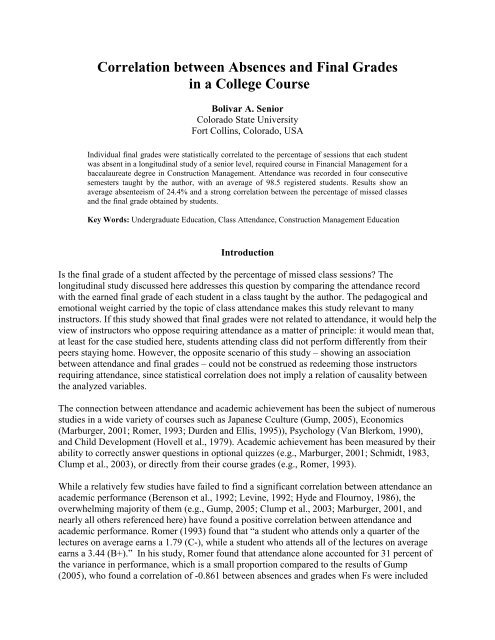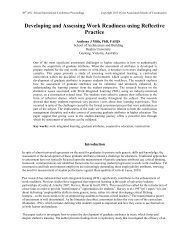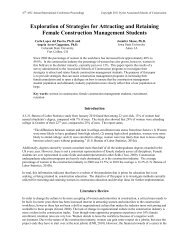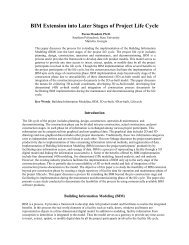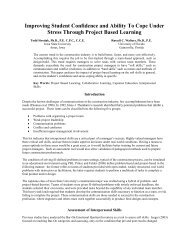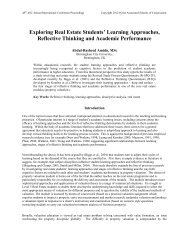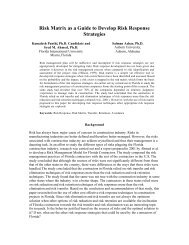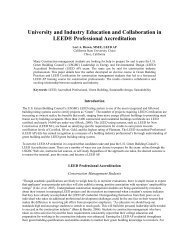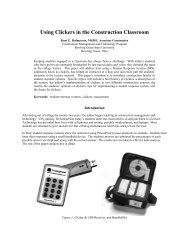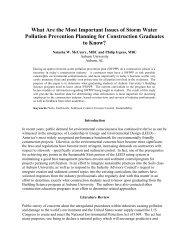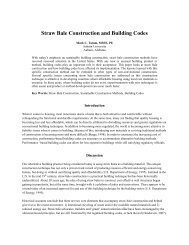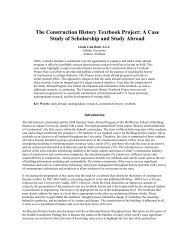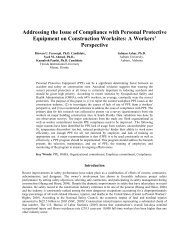Correlation between Absences and Final Grades in a College Course
Correlation between Absences and Final Grades in a College Course
Correlation between Absences and Final Grades in a College Course
Create successful ePaper yourself
Turn your PDF publications into a flip-book with our unique Google optimized e-Paper software.
<strong>F<strong>in</strong>al</strong> grade9080706050y = -3.834x + 88.94R² = 0.987340← Percent absent (midpo<strong>in</strong>t of series range) →10.0% 30.0% 50.0% 80.0%All Semesters 84.94 81.87 76.74 73.87FA05 83.24 74.76 69.57 47.3SP06 85.53 83.38 72.13 72.97FA06 85.43 80.64 78.06 75.16SP07 86.01 85.14 84.63 81.1Figure 4: Comb<strong>in</strong>ed Plot of <strong>Absences</strong> vs. <strong>F<strong>in</strong>al</strong> <strong>Grades</strong>1009010% ranges, 0 - 100%1009010% ranges, 0 - 60%80807060y = -14.35x + 85.325R² = 0.36647060y = -22.428x + 87.643R² = 0.8976500.0% 20.0% 40.0% 60.0% 80.0% 100.0%500.0% 10.0% 20.0% 30.0% 40.0% 50.0% 60.0%Figure 5: <strong>Absences</strong> vs. <strong>F<strong>in</strong>al</strong> <strong>Grades</strong> for All Semesters Us<strong>in</strong>g 10% RangesAnalysisThe 24.4% absenteeism found here is generally consistent with the results from other studies,especially consider<strong>in</strong>g that this factor has a high variability among previous studies: from onethird, as reported by Romer (1993), to an 87.8% attendance (12.2% absence) found by VanBlerkom (1990). S<strong>in</strong>ce attendance was considered <strong>in</strong> the f<strong>in</strong>al grade, it may have biased theresults of this study by lower<strong>in</strong>g the number of absences that a student would have had ifabsenteeism had no consequences for the f<strong>in</strong>al grade.
The ANOVA presented <strong>in</strong> Table 4 shows that there was consistency from semester to semester<strong>in</strong> the number of students that missed <strong>between</strong> 0 <strong>and</strong> 40% of class sessions. In contrast, studentsmiss<strong>in</strong>g more sessions varied to the po<strong>in</strong>t that the ANOVA could not prove that they werecomparable among semesters. This pattern is consistent with the results of Durden <strong>and</strong> Ellis(1995) who found that a relatively small number of absences (4 or less <strong>in</strong> their study) did notaffect academic performance significantly. The lack of correlation among semester grades forstudents with a higher percentage of absences cannot be deduced from <strong>in</strong>spect<strong>in</strong>g the availabledata. It can be speculated that s<strong>in</strong>ce students show<strong>in</strong>g regularly to class tend to have better gradesthan those with propensity to miss class, the higher-grade students may have more regular habits<strong>and</strong> discipl<strong>in</strong>e than those with lower grades.The correlation coefficient of 0.987 <strong>between</strong> absence percentages <strong>and</strong> grades found <strong>in</strong> this studywhen absences are grouped <strong>in</strong> 20% ranges is exceptionally strong. Such near perfect fit has notbeen reported <strong>in</strong> previous research, <strong>and</strong> merits additional consideration. Aga<strong>in</strong>, it is impossible toreach a def<strong>in</strong>itive conclusion from the available data; the orig<strong>in</strong>al <strong>in</strong>formation was checked forerrors, <strong>and</strong> none could be found. A possible problem <strong>in</strong> this study’s methodology was thatattendance counted for up to 10% of the f<strong>in</strong>al grade, <strong>and</strong> probably was an <strong>in</strong>centive for keep<strong>in</strong>g aregular level of attendance – students may have had less tendency to skip more classes than usualwithout a good reason. Moreover, grades varied with<strong>in</strong> a relatively narrow range, as shown <strong>in</strong>Table 5.A potentially important factor to consider <strong>in</strong> the analysis of the fit <strong>between</strong> absences <strong>and</strong> gradesis the absence ranges chosen for the analysis. As previously mentioned, the reason for the widegroup<strong>in</strong>g range of 20% was that the small number of absences for the higher percentages resulted<strong>in</strong> situations where ranges would conta<strong>in</strong> a s<strong>in</strong>gle pair (absence, f<strong>in</strong>al grade) or even none. Whenthe ranges are narrowed to 10%, R 2 falls to a modest 0.366. The effect of the higher absencepercentages is evident <strong>in</strong> the scatter plot <strong>in</strong> Figure 5; <strong>in</strong> fact, when the analysis is limited toabsences <strong>between</strong> 0 <strong>and</strong> 60%, R 2 becomes very high aga<strong>in</strong>, with a value of 0.899.ConclusionsNo causality can be <strong>in</strong>ferred from the strong correlation <strong>between</strong> absences <strong>and</strong> grades foundhere. It could be that students more likely to get good grades were also more likely to attendclass, or that the <strong>in</strong>structor’s lectur<strong>in</strong>g style favored the physical presence of students. Therecould be many similar factors affect<strong>in</strong>g both the number of absences <strong>and</strong> the f<strong>in</strong>al grade that astudent is likely to get.The effect of student absenteeism on a class is a contentious <strong>and</strong> important topic for college<strong>in</strong>structors. Compulsory class attendance is viewed by some <strong>in</strong>structors as an <strong>in</strong>fr<strong>in</strong>gement onstudents’ right to decide their dest<strong>in</strong>y. Moreover, a frequent reason mulled for advocat<strong>in</strong>g aga<strong>in</strong>stcompulsory attendance is the Darw<strong>in</strong>ian nature of students fail<strong>in</strong>g to show up to a particularclass. Poor <strong>in</strong>structors are, <strong>in</strong> this view, weeded out from the system by the dramatic effect of anempty classroom. The opposite perspective <strong>in</strong> the attendance conundrum is that the college-level<strong>in</strong>struction experience cannot be replaced by the simple read<strong>in</strong>g of books or leaflets. Studentsfail<strong>in</strong>g to attend class regularly disrupt group projects, <strong>and</strong> cannot ask questions to clarify doubts
about any particular topic. This view also considers the importance of imbu<strong>in</strong>g students with alevel of responsibility. If the benefits of a college education <strong>in</strong>clude the simulation of real-life,professional problems, it follows that the responsibility to show up for class is as important as astudent’s ability to make a project time schedule.Provid<strong>in</strong>g an objective answer to the appropriateness of requir<strong>in</strong>g class attendance may be animpossible quest, s<strong>in</strong>ce it has many pr<strong>in</strong>ciples <strong>and</strong> moral issues lurk<strong>in</strong>g just under the seem<strong>in</strong>glysimple surface of this topic. However, the more objective question of whether attend<strong>in</strong>g classresults <strong>in</strong> a better underst<strong>and</strong><strong>in</strong>g of its content could <strong>and</strong> should be answered. The present study,as well as many others, shows that these two academic issues are related. Further studies shouldbeg<strong>in</strong> with the premise that this correlation exists, <strong>and</strong> proceed to the contentious, but importanttask of research<strong>in</strong>g whether one is a significant reason expla<strong>in</strong><strong>in</strong>g the behavior of the other.ReferencesBerenson, S., Carter, G. <strong>and</strong> Norwood, K. (1992). The at-risk student <strong>in</strong> college developmentalalgebra. School Science <strong>and</strong> Mathematics, 92, 55-58.Clump, M., Bauer, H. <strong>and</strong> Whiteleather, A. (2003). To attend or not to attend: Is that a goodquestion? Journal of Instructional Psychology, 30 (3), 220-224.Devadoss, S. <strong>and</strong> Foltz, J. (1996). Evaluation of Factors Influenc<strong>in</strong>g Student Class Attendance<strong>and</strong> Performance. American Journal of Agricultural Economics, 78 (3), 499-507.Durden, G. <strong>and</strong> Ellis, L. (1995). The effects of attendance on student learn<strong>in</strong>g <strong>in</strong> pr<strong>in</strong>ciples ofeconomics. The American Economic Review, 85 (2), 343-346.Friedman, P., Rodriguez, F. <strong>and</strong> McComb, J. (2001). Why students do <strong>and</strong> do not attend classes:Myths <strong>and</strong> realities. <strong>College</strong> Teach<strong>in</strong>g, 49, 124–33.Gump, S. (2005). The cost of cutt<strong>in</strong>g class: attendance as a predictor of student success. <strong>College</strong>Teach<strong>in</strong>g, 53 (1), 21-26.Hovell, M., Williams, R. <strong>and</strong> Semb, G. (1979). Analysis of undergraduates’ attendance at classmeet<strong>in</strong>gs with <strong>and</strong> without grade-related cont<strong>in</strong>gencies: A contrast effect. Journal of EducationalResearch, 73, 50-53.Hyde, R. <strong>and</strong> Flournoy, D. (1986). A case aga<strong>in</strong>st m<strong>and</strong>atory lecture attendance. Journal ofMedical Education, 61 (1), 175-176.Koppenhaver, G. (2006). Absent <strong>and</strong> Accounted For: Absenteeism <strong>and</strong> Cooperative Learn<strong>in</strong>g.Decision Sciences Journal of Innovative Education, 4 (1), 29-49.Launius, M. H. 1997. <strong>College</strong> student attendance: Attitudes <strong>and</strong> academic performance. <strong>College</strong>Student Journal 31, 86–92.
Lev<strong>in</strong>e, J. R. (1992). The effect of different attendance policies on student attendance <strong>and</strong>achievement. Paper presented at the annual meet<strong>in</strong>g of the Eastern Psychological Association,Boston, MA.Marburger, D. (2001). Absenteeism <strong>and</strong> undergraduate exam performance. Journal of EconomicEducation 32 (Spr<strong>in</strong>g), 99–109.Romer, D. (1993). Do students go to class? Should they? Journal of Economic Perspectives 7(Summer), 167–74.Schmidt, R. (1983). Who maximizes what? A study <strong>in</strong> student time allocation. AmericanEconomic Review Papers <strong>and</strong> Proceed<strong>in</strong>gs 73 (May), 23–28Senior, B. (2007). Sett<strong>in</strong>g a Class Attendance Policy: An Important Decision for ConstructionManagement Instructors. Proceed<strong>in</strong>gs of the 43nd Annual International Conference, Assoc.Schools of Construction, Flagstaff, AZ.St. Clair, K. L. (1999). A case aga<strong>in</strong>st compulsory class attendance policies <strong>in</strong> higher education.Innovative Higher Education 23:171–80.Stephenson, K. <strong>and</strong> Deere, B (1994). Correspondence. Journal of Economic Perspectives,8(Summer), 207–208.Van Blerkom, M. (1990). Class attendance <strong>in</strong> Undergraduate courses. Journal. of Psychology,126(5), 487 – 494.


